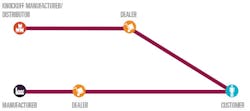The Many Shades of Gray
Compiled by Erin Robinson, Associate Editor
OFF-WHITE
Domestic
The manufacturer authorizes the dealer to sell licensed products to the customer. If anything goes wrong with the product during the customer's usage, there is recourse because the product can be traced through the supply chain.
International
The manufacturer hires a distributor to find dealers who then find customers in that country. Again, if anything goes wrong with the product during the customer's usage, there is recourse because the product can be traced through the supply chain.
These scenarios are "off-white" rather than "white" because it's always possible for error to occur with a dental product (just as with all other products-even food), even if it never left its intended supply chain.
GRAY VERY GRAY
Dealer 1 is authorized to sell the manufacturer's products. But, for whatever reason, he decides that he can sell to Dealer 2 (who is unauthorized and who is also working within the same market as Dealer 1). For example, he might get a discount if he buys a certain amount of product, so he decides to buy that amount and sell what he doesn't want to Dealer 2. This is a less common scenario due to both dealers being in the same market. This is considered "gray" because even though the dealer is unauthorized, the product is staying within the same market in which it is licensed for sale.
Dealer 1 works within a certain geographical area-be it a region, state, or country-and buys more products than he needs for that area (again, perhaps he was able to get a discount for buying a certain amount). To dispose of what he doesn't need, he sells it to another dealer who is outside of his own market due to location in another state, region, or country. This is a more common scenario than the "gray" example above, but it's still unlikely due manufacturers' efforts to track product sales. This can be considered "very gray" because the product might travel into a market where it is not licensed for sale.
In either of the scenarios above, the diverted products can pose problems for dentists. If a dentist purchases from Dealer 2 and then has an issue with the product, there is no recourse and the manufacturer will not service the product. This is because Dealer 2 is not authorized to sell the product, and the manufacturer has no control over the shipping, storage, and handling.
The "grayer"/"darker" an item gets, the less expensive it gets.
The "grayer"/"darker" an item gets, the more risk there is for the dentist.
What's the incentive for distributors, dealers, brokers, wholesalers, counterfeiters, etc., to get involved in the gray market? By one estimation, the gray market is approximately a $1.5-billion market in the US.
MUCH TOO GRAY
This is primarily how the gray market works today.
At the base, there's a "pipeline," resembling the off-white diagram that illustrates how the international supply chain is supposed to work. What often happens, however, is that products are discounted when they are sold internationally because customers in many markets cannot afford the same prices as customers in the US market. In addition, products intended for third-world or emerging markets are often made with different packaging or different product counts and sometimes with a slightly different formulation.
Due to the opportunities that are available to all parties involved in the supply chain as a result of the low cost of the product, the supply chain can break at any stage (hence the three lines that vertically derive from the base "pipeline" of the diagram). When the supply chain is broken by the diversion of products, it's nearly impossible to know at which point it is broken.
But somewhere along the way, someone (it could be the distributor, the dealer, or a freight-forwarder who is in charge of receiving the shipment of products on behalf of the distributor) sells some of that cheaper product outside of its intended market to someone on the other side of a border. The person they sell to might be another distributor or dealer, or it might be a broker or wholesaler who sells product all over the world.
If it is a broker, the broker might sell to additional dealers. If it is a distributor or dealer, that distributor or dealer might sell to additional dealers. There is no way to know who is selling what to whom, where the product travels, how long any entity is holding on to a product before passing it along, or how the product is stored, shipped, and handled along the way.
These products often end up back in the United States where they may not be licensed by the FDA (and may therefore be illegal) if they are intended for different markets.
Black
Eventually, someone working within the gray market as depicted in the previous diagram gets tired of all of the different products they're encountering ... and so the gray marketer decides to get into the business of making knockoffs. THIS IS THE BLACK MARKET. A product typically manufactured in tiny tubes due to its chemistry might instead be manufactured in a barrel when it's counterfeit. Often, authentic containers are purchased as well as labels to match the authentic products.
Like the "much too gray" products that can cross borders to return to the US where they are not necessarily licensed by the FDA, these products are illegal.
For a downloadable infographic, click here.
SOURCE: Bernie Teitelbaum, Executive Director of the Dental Industry Association of Canada (DIAC)
DESIGN: PennWell Corporation






